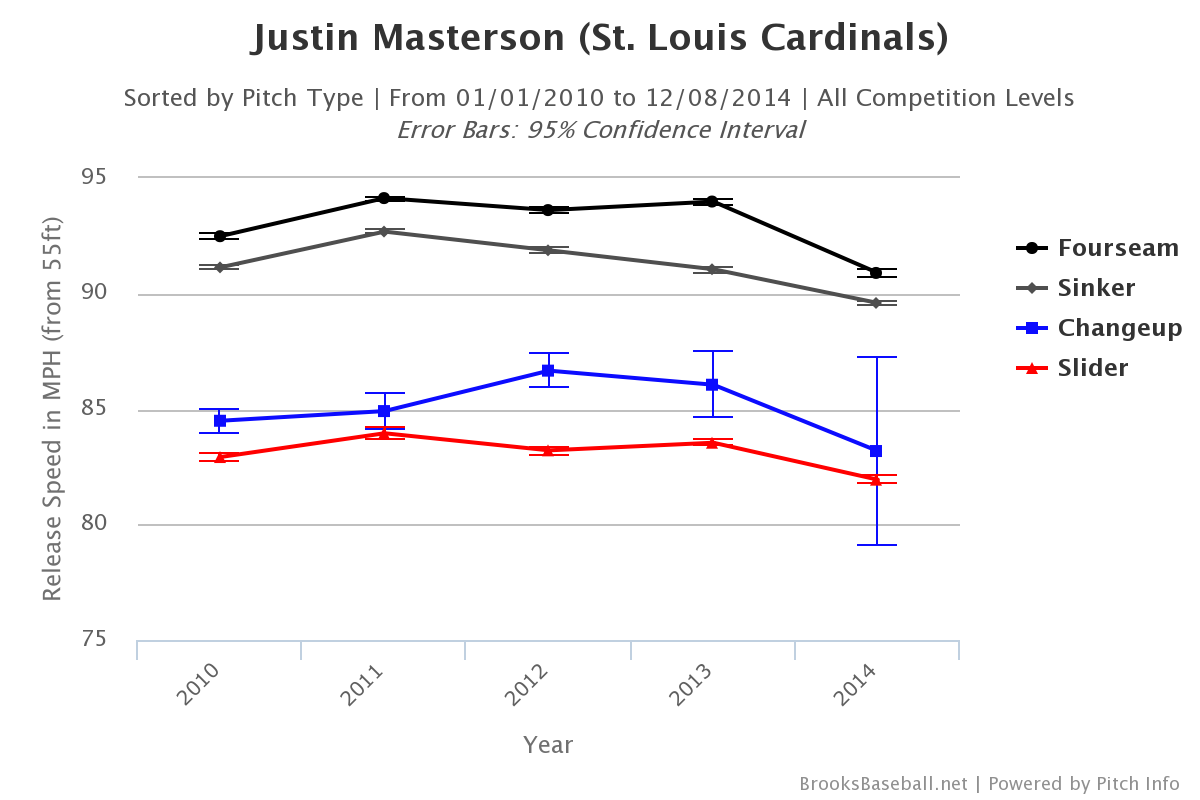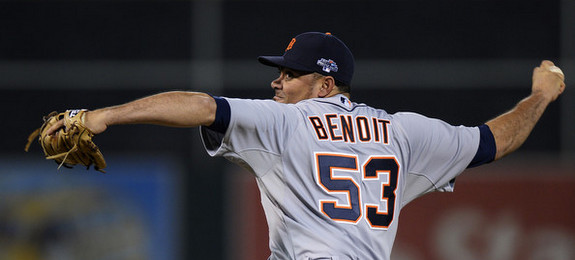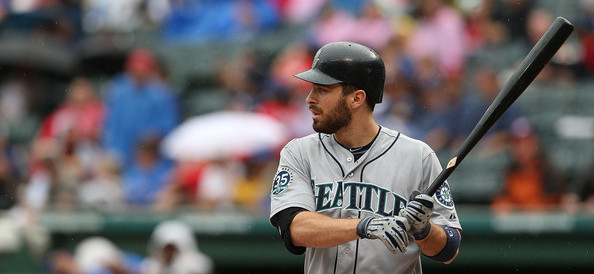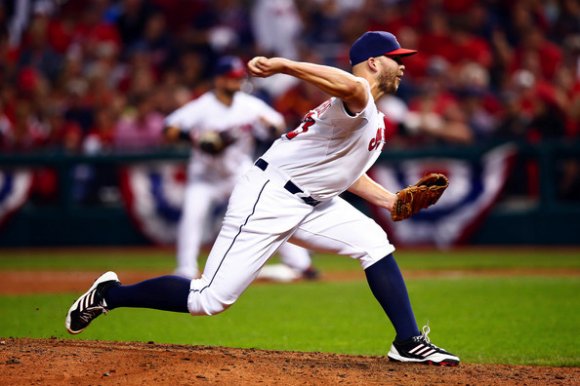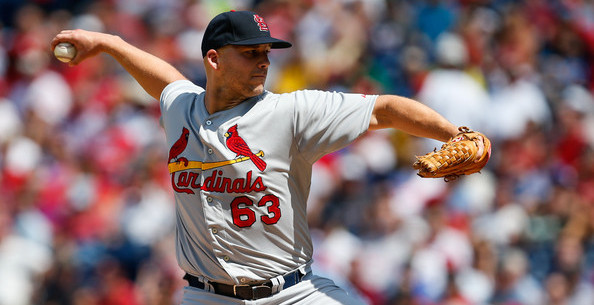
At the Winter Meetings this week and really throughout the rest of the offseason, the Yankees will be on the lookout for pitching. Rotation help and general depth. Their top four returning starters — Masahiro Tanaka (elbow), Michael Pineda (shoulder), CC Sabathia (knee), and David Phelps (elbow) — all have some kind of injury concern and the club needs to protect themselves. Expect them to kick the tires on everyone still available on the market, which includes basically every free agent pitcher.
One of those free agent pitchers is right-hander Justin Masterson, who will turn 30 in March. He had a miserable 2014 season with the Indians and Cardinals — St. Louis left him off their postseason roster — and is now looked at as something of a reclamation project. At this time last year he was considered a staff anchor who could fill any of the top three spots in a rotation on a given day. That is no longer the case. The Yankees need to add some certainty to their rotation, someone they can count on for innings, and Masterson may or may not fit the bill. Let’s look.
Up And Down Performance
Usually in this section I’ll put together a table with the player’s performance over the last three or four years, but with Masterson I think it’s best to post some graphs just to really drive home how up and down his performance has been the last few years. Check it out:
Masterson has alternated some really excellent seasons with some really awful seasons since his first full season as a starter in 2010. His strikeout rates have remained pretty much in line with the league average over the years while his ground ball rates have been consistently excellent, well above the league average and close to 60% of balls in play. As bad as 2014 was, he still had a 58.2% grounder rate. That’s as good as it gets.
Because he only has an average strikeout rate and is an extreme ground ball pitcher, Masterson’s success depends heavily on his infield defense. His batting average on balls in play has been consistently above .305 through his career with the exception of the 2013 season, when it was a career-low .285. Masterson’s walk rate shot up 11.7% this past season after sitting right around 9.5% from 2010-13, so he will walk some guys. More than anything, Masterson’s biggest problem is his vulnerability against left-handed pitchers. Check it out:
| RHB wOBA | RHB K% | RHB BB% | RHB GB% | LHB wOBA | LHP K% | LHP BB% | LHP GB% | |
|---|---|---|---|---|---|---|---|---|
| 2010 | .307 | 22.8% | 7.5% | 62.6% | .350 | 13.1% | 10.4% | 57.8% |
| 2011 | .259 | 22.8% | 9.6% | 61.0% | .327 | 13.3% | 5.3% | 51.4% |
| 2012 | .277 | 23.3% | 8.6% | 59.0% | .360 | 13.5% | 10.5% | 53.6% |
| 2013 | .238 | 32.0% | 7.1% | 63.6% | .316 | 19.4% | 10.9% | 55.0% |
| 2014 | .332 | 25.5% | 11.6% | 63.1% | .400 | 14.5% | 11.7% | 54.5% |
| Average | .281 | 25.0% | 8.8% | 61.6% | .347 | 14.8% | 9.6% | 54.3% |
Overall, Masterson’s performance has gone up and down these last few years, and wouldn’t you know it? So has his performance against lefties. When he is reasonably effective against lefties — almost all of that success is BABIP-related too, his strikeout, walk, and grounder rates have remained fairly steady against left-handers over the years — he’s a very good pitcher overall. When not, well, he’s basically an average innings eater.
We’ll get to why Masterson dominates righties but struggles against lefties in a little bit when we look at his stuff, but for now we just need to know that he’s essentially a platoon pitcher. Yankee Stadium is not a good place to struggle against lefties because of the short right field porch, though Masterson’s grounder heavy ways would mitigate that somewhat. After more than 1,000 innings in the big leagues, improving against left-handers doesn’t seem like something that will just happen. The inability to consistently retire lefties is just something you’ll have to live with.
Stuff Breakdown
Masterson is a huge guy — he’s listed at 6-foot-6 and 250 lbs. — yet he has a very low arm slot and releases the ball almost behind a righty batter, similar to Randy Johnson, just from the other side. Masterson’s delivery is all arms and legs too. Big leg kick, long arm action in the back, everything’s moving and whipping around. I can’t imagine he’s a comfortable at-bat, especially for same-side hitters. Check it out:
Between the utter lack of a changeup and the easy to see low arm slot, it’s no surprise Masterson has struggled against left-handed batters throughout his career. They can pick up the ball out of hands well and he doesn’t have a pitch to get them out. He basically has to hope they beat his sinker into the ground or come up empty against the slider. There’s nothing that moves away from lefties and keeps the ball off the barrel of the bat. At the same time, the sinker/slider/arm slot combo is hell on righties.
Both the sinker and slider have been above-average at getting both swings and misses and ground balls over the years — even in 2014 — while the four-seamer is very slightly below-average at both. From 2010-2013, the sinker/slider/four-seamer repertoire got the job done for Masterson and he was a quality MLB starter. That wasn’t the case this past season, and, probably not coincidentally, his velocity dropped off noticeably. From Brooks Baseball:
Masterson’s average sinker velocity has gradually declined from 92.74 mph in 2011 to 89.68 mph in 2014, though the drops in four-seam fastball and slider velocity are much more drastic. Masterson’s four-seamer sat 94.11 mph in 2013 and 90.97 mph in 2014. The slider went from 83.67 mph to 82.05 mph from 2013-14. We’re talking about losing three miles an hour off the four-seamer and one and half miles an hour off the slider. That’s huge. So huge that I can’t help but wonder if something is physically wrong.
If you’re a team looking to sign Masterson, you almost have to hope he was either a mechanical mess this summer or was hiding some kind of minor injury. Something that explains the velocity loss because usually velocity doesn’t come back on its own unless there was a physical or mechanical problem. Masterson’s control isn’t good enough — just look at his walk rates in the graph above — to get by with reduced velocity. We saw it last year. Masterson with a low-90s sinker and mid-80s slider is a much different animal than Masterson with an upper-80s sinker and low-80s slider. The latter is far less effective.
Injury History
Masterson has been on the DL just once in his career, and it was for right knee inflammation this past July. A balky knee could explain the loss in velocity, especially since it is his push-off leg. He was out a little more than three weeks with the knee and was actually traded to the Cardinals while on the DL. Masterson had a 5.51 ERA (4.08 FIP) before the knee injury and a 7.04 ERA (5.84 FIP) after, so getting healthy didn’t help his performance.
Other than the knee, Masterson did miss three weeks with an oblique strain in September 2013, though the Indians never bothered to place him on the DL because rosters were expanded. So it’s really two DL worthy injuries in his career but only one actual DL stint. Masterson also had arthroscopic surgery to repair a slight tear in his left (non-pitching!) shoulder during the 2011-12 offseason. He was healthy in time for Spring Training and hasn’t had any problems since. Oblique strains happen. This knee issue is a much bigger concern. What caused the inflammation?
Contract Estimates
The Indians and Masterson discussed a contract extension last offseason. Jon Heyman said Masterson was reportedly looking for two or three years at $17M annually — considering his performance from 2010-13, that was a pretty damn reasonable contract demand — while the Tribe countered with a two-year pact worth $30M. The two sides broke off talks and now the consensus is Masterson is looking at a one-year contract to rebuild value.
- FanGraphs Crowdsourcing: One year at $9M.
- Jim Bowden (subs. req’d): One year at $7M.
- Keith Law (subs. req’d): “If he’ll take $5 million a year and agree to work in relief, he’s good value, but if he wants starter money and a rotation job, I’m out.”
Did the Indians know Masterson’s stuff was about to decline and that’s why they didn’t meet his asking price? I don’t think we can rule it out, maybe they had some concern about his long-term outlook, but predicting a pitcher will lose three miles an hour off his fastball from one year to the next seems like something that can’t be done. Maybe I’m wrong. Either way, Masterson’s looking at a one-year contract, probably in the $5M to $10M range.
Wrapping Up
The Yankees need to fill multiple rotation spots this winter after trading Shane Greene for Didi Gregorius. Going big for Max Scherzer or Jon Lester would be a huge help, but in the end those guys are still only filling one rotation spot. The club figures to scour the second and third tier of the pitching market and that’s where Masterson sits. In all likelihood he will only get a one-year contract, so he’s relatively low risk in that regard, but the velocity loss and career-long struggles against lefties make him high risk on the field. Even with the fallback of being reliever — Masterson’s pitched out of the bullpen before and been very effective — there’s a chance he’s just a bad pitcher now. It happens.
Looking at this from Masterson’s perspective, if he’s going to take a one-year contract to rebuild value, Yankee Stadium probably isn’t the best place to do it. Even as a ground ball pitcher. Most guys in his situation gravitate towards teams will bigger ballparks even though clubs nowadays are aware of park effects and can see through superficial stats like ERA. Big ballpark teams like the Twins, Marlins, Tigers, Giants, and Braves have all reportedly been in touch with Masterson so far this winter, so unless the Yankees really make it worth his while financially, the right-hander will probably head somewhere that is a little easier to pitch.
